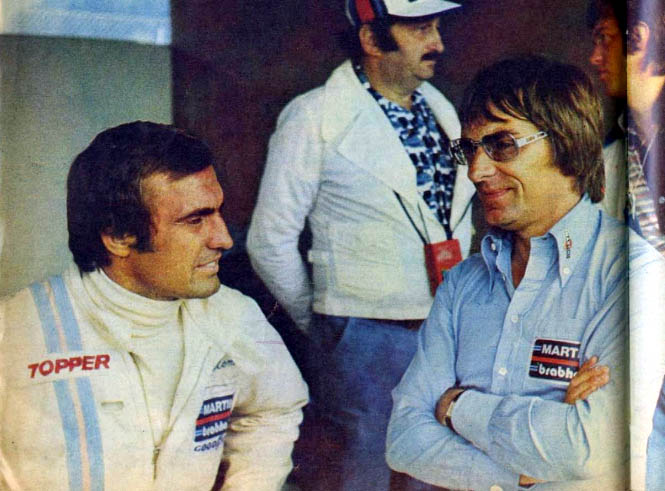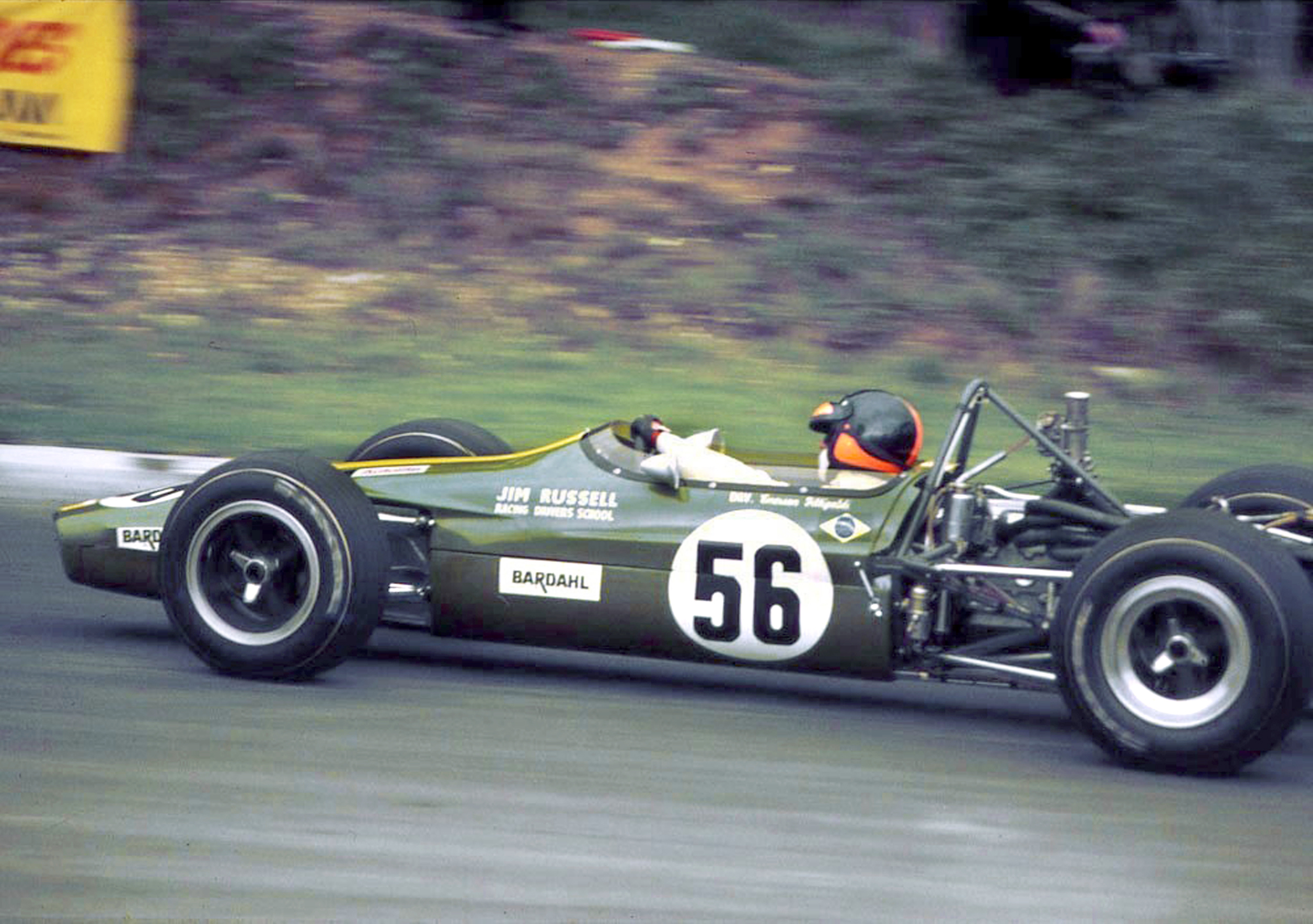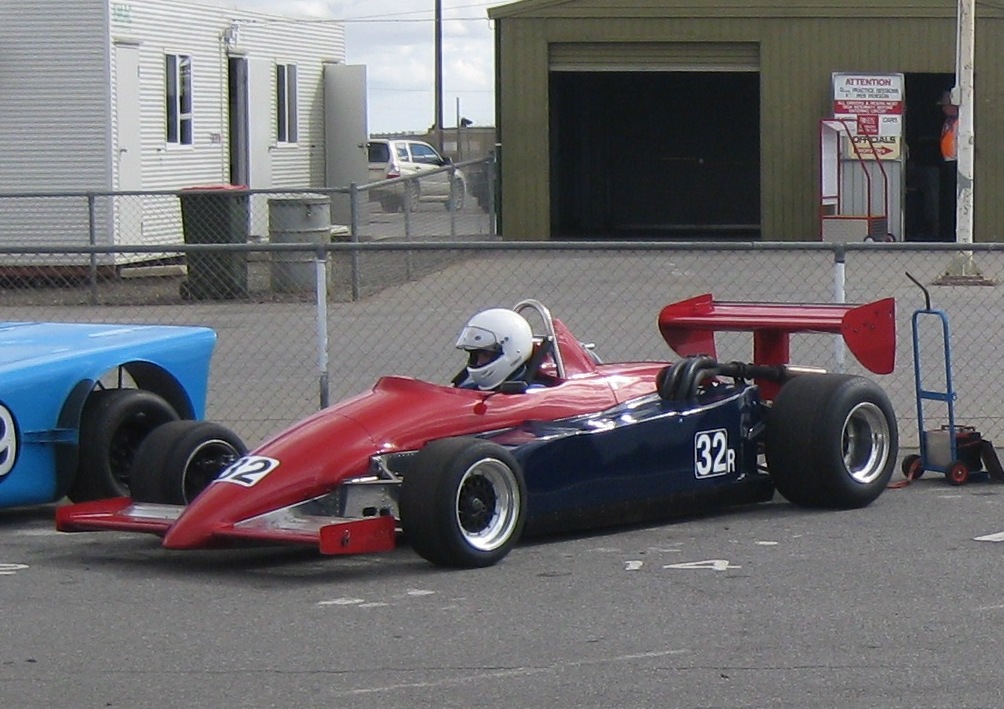|
Formula 3
Formula Three, also called Formula 3, abbreviated as F3, is a third-tier class of open-wheel formula racing. The various championships held in Europe, Australia, South America and Asia form an important step for many prospective Formula One drivers. History Formula Three (adopted by the FIA in 1950) evolved from postwar auto racing, with lightweight tube-frame chassis powered by 500 cc motorcycle engines (notably Nortons and JAP speedway). The 500 cc formula originally evolved in 1946 from low-cost "special" racing organised by enthusiasts in Bristol, England, just before the Second World War; British motorsport after the war picked up slowly, partly due to petrol rationing which continued for a number of years and home-built 500 cc cars engines were intended to be accessible to the "impecunious enthusiast". The second post-war motor race in Britain was organised by the VSCC in July 1947 at RAF Gransden Lodge, 500cc cars being the only post-war class to run that day. Three ... [...More Info...] [...Related Items...] OR: [Wikipedia] [Google] [Baidu] |
Cooper Car Company
The Cooper Car Company is a British car manufacturer founded in December 1947 by Charles Cooper and his son John Cooper. Together with John's boyhood friend, Eric Brandon, they began by building racing cars in Charles's small garage in Surbiton, Surrey, England, in 1946. Through the 1950s and early 1960s they reached motor racing's highest levels as their mid-engined, single-seat cars competed in both Formula One and the Indianapolis 500, and their Mini Cooper dominated rally racing. The Cooper name lives on in the Cooper versions of the Mini production cars that are built in England, but is now owned and marketed by BMW. Origins The first cars built by the Coopers were single-seat 500-cc Formula Three racing cars driven by John Cooper and Eric Brandon, and powered by a JAP motorcycle engine. Since materials were in short supply immediately after World War II, the prototypes were constructed by joining two old Fiat Topolino front-ends together. According to J ... [...More Info...] [...Related Items...] OR: [Wikipedia] [Google] [Baidu] |
Motor Sport (magazine)
''Motor Sport'' is a monthly motor racing magazine, founded in the United Kingdom in 1924 as the ''Brooklands Gazette''. The name was changed to ''Motor Sport'' for the August 1925 issue. The magazine covers motor sport in general, although from 1997 to 2006 its emphasis was historic motorsport. It remains one of the leading titles on both modern and historic racing. The magazine's photo library is currently managed by LAT Images, which founded as Motor Sport photographic division by Wesley J. Tee in the 1960s and later spun-off as a stand-alone affiliated company. The magazine's monthly podcasts have featured Christian Horner, Mario Andretti, Patrick Head, Sir Frank Williams, John McGuinness and Gordon Murray. In 1939 the magazine incorporated its rival ''Speed'' (the organ of the British Racing Drivers' Club). Editors * 1936–1991: Bill Boddy * ? – December 1996: Simon Arron * April 1997 – ?: Andrew Frankel (acting editor January 1997 – March 1997) * Sept ... [...More Info...] [...Related Items...] OR: [Wikipedia] [Google] [Baidu] |
Bernie Ecclestone
Bernard Charles Ecclestone (born 28 October 1930) is an English business magnate. He is the former chief executive of the Formula One Group, which manages Formula One motor racing and controls the commercial rights to the sport, and part-owns Delta Topco, the previous ultimate parent company of the Formula One Group. As such, he was commonly described in journalism as the 'F1 Supremo'. Ecclestone entered two Grand Prix races as a driver, during the 1958 season, but failed to qualify for either of them. Later he became manager of drivers Stuart Lewis-Evans and Jochen Rindt. In 1972, he bought the Brabham team, which he ran for 15 years. As a team owner he became a member of the Formula One Constructors Association. His control of the sport, which grew from his pioneering sale of the television rights in the late 1970s, was chiefly financial, but under the terms of the Concorde Agreement he and his companies also managed the administration, setup and logistics of each Formula ... [...More Info...] [...Related Items...] OR: [Wikipedia] [Google] [Baidu] |
Ken Tyrrell
Robert Kenneth Tyrrell (3 May 1924 – 25 August 2001) was a British Formula Two racing driver and the founder of the Tyrrell Formula One constructor.Setright, L. J. K. "Tyrrell: A Shrewd Talent-spotter", in Northey, Tom, ed. ''World of Automobiles'' (London: Orbis, 1974), Vol. 21, p.2417. Biography Born in East Horsley, Surrey, Tyrrell served in the Royal Air Force during World War II. After the war he became a timber merchant; as a result, he was sometimes known as "Chopper". In 1952, at 28, he began racing a Norton-powered Cooper in Formula 3. In 1958, he advanced to Formula Two in a Cooper-Climax, joining Cecil Libowitz and Alan Brown. He achieved a number of good placings and the occasional win. Realising, however, that he was not going to reach the top and recognising that his talents were better suited to team management, Tyrrell stood down as a driver in 1959 and began to run the works Cooper Formula Junior team, using the woodshed owned by his family business, Ty ... [...More Info...] [...Related Items...] OR: [Wikipedia] [Google] [Baidu] |
Don Parker (racing Driver)
Don Parker (11 November 1908 – 20 May 1997) was a British racing driver from England who was British Formula Three Champion on three occasions (1952, 1953 and 1959). He also competed in the British Saloon Car Championship. Racing career Early career Parker was born in Ramsgate, Kent, UK and did not see a motor race until he was 40 years of age. In the late 1940s, Parker was running a small engineering firm in South London and inherited a racing car from an adjacent company. He adapted this to better suit his own slight build and it made a winning debut at Brough in April 1949. He took three other podium finishes that year and set fastest time in his class at the Brighton Speed Trials. The next season (1950), 500cc racing became recognised by the Fédération Internationale de l'Automobile (FIA) as Formula Three. Parker drove his JAP-engined "special" in competition to the Norton-equipped works and privateer Coopers. In theory, his home-produced car should not have bee ... [...More Info...] [...Related Items...] OR: [Wikipedia] [Google] [Baidu] |
Peter Collins (racing Driver)
Peter John Collins (6 November 1931 – 3 August 1958) was a British racing driver. He was killed in the 1958 German Grand Prix, just weeks after winning the RAC British Grand Prix. He started his career as a 17-year-old in 1949, impressing in Formula 3 races, finishing third in the 1951 Autosport National Formula 3 Championship. Early life and racing career Born on 6 November 1931, Collins grew up in Mustow Green, Kidderminster, Worcestershire, England. The son of a motor-garage owner and haulage merchant, Collins became interested in motor vehicles at a young age. He was expelled from school at 16 owing to spending time at a local fairground during school hours. He became an apprentice in his father's garage and began competing in local trials races. In common with many British drivers of the time, Collins began racing in the 500 cc category (adopted as Formula 3 at the end of 1950), when his parents bought him a Cooper 500 from the fledgling Cooper Car Company. S ... [...More Info...] [...Related Items...] OR: [Wikipedia] [Google] [Baidu] |
Jim Russell (racing Driver)
Herbert James Russell (28 May 1920 – 30 March 2019), better known as Jim Russell, was an English racing driver, garage owner and founder of the Jim Russell Racing Driver School. He died on 30 March 2019, shortly after undergoing an operation for a hip replacement. Early life and garage Russell was born at his parents' fish and chip shop and lived most of his life in Downham Market, Norfolk. His first job was selling ice cream. Jim Russell Garage from Eastern Daily Press. Retrieved 2014-01-10 After serving with the Royal Air Force, RAF during World War II, he became a garage owner. By 1960, the garage, |
Ivor Bueb
Ivor Léon John Bueb (6 June 1923 – 1 August 1959) was a British professional sports car racing and Formula One driver from England. Career Born in East Ham, Essex east of London, Bueb started racing seriously in a Formula Three 500cc Cooper in 1953, graduating to the Cooper works team in 1955 when he finished second in the British championship. He made occasional starts in Grands Prix in 1957 with a Connaught and a Maserati run by Gilby Engineering. The following year he raced Bernie Ecclestone's Connaught at Monaco, and drove a Formula Two Lotus at the German Grand Prix. In 1959 he had two outings for BRP, firstly a non-qualification at Monaco, then another Formula Two entry at the British Grand Prix. He participated in six Formula One World Championship Grands Prix in all, but scored no championship points. He also participated in numerous non-Championship Formula One races. With the death of Archie Scott Brown at Spa in May 1958, Brian Lister hired Bueb to fill t ... [...More Info...] [...Related Items...] OR: [Wikipedia] [Google] [Baidu] |
Stuart Lewis-Evans
Stuart Nigel Lewis-Evans (20 April 1930 – 25 October 1958) was a British racing driver from England. He participated in 14 Formula One World Championship Grands Prix, debuting on 19 May 1957. He achieved two podiums, and scored a total of 16 championship points. He also achieved two pole positions. Early life Stuart Lewis-Evans was born in Luton, Bedfordshire, but largely grew up in Kent, where his father, Lewis "Pop" Lewis-Evans, owned and ran a garage business. Pop Lewis-Evans had previously been a mechanic for the well-known racing driver Earl Howe, but had not previously raced himself. On leaving school, Lewis-Evans was apprenticed for three years to Vauxhall Motors, back in Bedfordshire, before he was called up for National Service. During this time he served as a motorcycle despatch rider for the Royal Corps of Signals. Career Lewis-Evans began racing in 1951 with a Cooper 500 Formula 3 car, encouraged by and sometimes racing against his father. He achieved many wi ... [...More Info...] [...Related Items...] OR: [Wikipedia] [Google] [Baidu] |
Stirling Moss
Sir Stirling Craufurd Moss (17 September 1929 – 12 April 2020) was a British Formula One racing driver. An inductee into the International Motorsports Hall of Fame, he won 212 of the 529 races he entered across several categories of competition and has been described as "the greatest driver never to win the World Championship". In a seven-year span between 1955 and 1961 Moss finished as championship runner-up four times and in third place another three times. Early life Moss was born in London, son of Alfred Moss, a dentist of Bray, Berkshire, and Aileen (née Craufurd). His grandfather was Jewish, from a family that changed their surname from Moses to Moss. He was brought up at ''Long White Cloud'' house on the south bank of the River Thames. His father was an amateur racing driver who had come 16th in the 1924 Indianapolis 500. Aileen Moss had also been involved in motorsport, entering prewar hillclimbs at the wheel of a Singer Nine. Stirling was a gifted horse rider ... [...More Info...] [...Related Items...] OR: [Wikipedia] [Google] [Baidu] |
Ralt
Ralt was a manufacturer of single-seater racing cars, founded by ex- Jack Brabham associate Ron Tauranac after he sold out his interest in Brabham to Bernie Ecclestone. Ron and his brother had built some specials in Australia in the 1950s under the Ralt name (standing for Ron and Austin Lewis Tauranac). Tauranac won the 1954 NSW Hillclimb Championship in the Ralt 500. Cars Early Ralts Built with the assistance of Tauranac's younger brother, Austin, in Australia. The Mk was powered by a 1,932cc pushrod Norton ES2. Tauranac made his own flywheel, connecting rods, and cylinders. The Mk2 was a sports car built by and for Austin, with a Ford 10 engine, Standard 10 gearbox, and Morris 8 rear axle. The Mk3 was purchased from the Hooper brothers when they retired. Tauranac designed a new chassis for it, and the car was primarily driven by Austin. The Mk4 began as a special, using a Vincent-HRD V-twin and a de Dion rear suspension. The car took two years to develop in Tauranac' ... [...More Info...] [...Related Items...] OR: [Wikipedia] [Google] [Baidu] |





